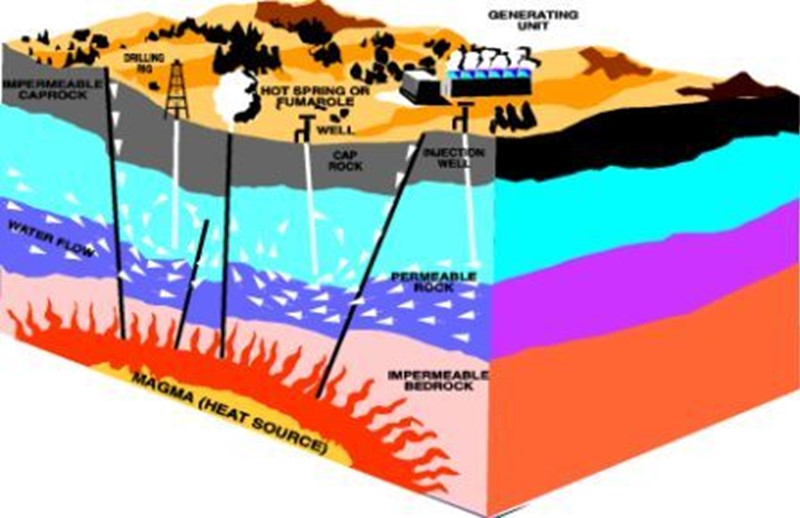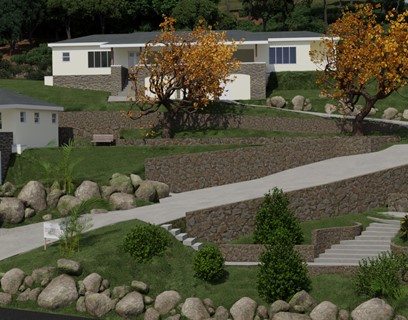
The name "geothermal" is derived from two Greek words, "geo" meaning earth and "thermal" meaning heat, giving rise to the term "heat from the earth". The earth's centre is hot enough to melt rock at about 6000 degrees celcius. Closer to the earth's surface, at even a few miles down, the temperature has been measured at over 250 degrees celcius. In volcanic areas, molten rock is sometimes very close to the surface.
Geothermal energy has been used for cooking and heating for thousands of years in some countries. Iceland, with a high concentration of volcanoes is one such country.
How does a geothermal plant function? It is fuelled by hot rock underground which heats water to produce steam. However, one must drill down to this hot region, pipe the steam up, purify it, and use it to drive steam turbines which then drive electric generators.
Under ideal conditions a geothermal plant will tap into a natural pocket of superheated steam in a hot region. This is not as simple as it sounds. Firstly, there must be a natural groundwater region in the hot rocks, and then one has to be able to drill down and tap into it. If there is no natural ground water near the hot region, water from a nearby source can be piped down to the hot region and the resulting steam piped back to run the steam turbines.
Assuming that that there is a ready supply of ground water near the hot region, or water is near to and can be easily transported to the hot region in Montserrat, either situation will give the island a huge advantage particularly set against fossil fuel (diesel) generation.
On the plus side:
- 1) Geothermal energy does not produce the kind of pollution that contributes to the greenhouse effect.
- 2) Power stations also fit into smaller spaces and lesson the environmental impact.
- 3) No fossil fuel (diesel) should be needed ... or at least we can expect a substantial reduction in our dependence on diesel. The cost savings can be up to 80% in some cases.
- 4) Once a geothermal plant is commissioned, the energy produced is almost free. However, a conventional supply (diesel) may be required to start or run any associated pumping facilities, but once in full operation, the pumps can be loaded on to a supply taken from the energy generated by the geothermal plant.
That is all well and good in an ideal world. Take it from me, if ever there was a saying that "there is no such thing as a free lunch", bet your bottom dollar, this geothermal issue is a testament to that.
On the minus side:
- 1) The biggest problem will be in site selection. That is because there are not many places where a geothermal plant can actually be built. A particular type of hot rock is required and they must be at a depth where they can be drilled down to. The type of rocks near the surface is also of importance. They must be of a type that facilitates easy drilling to access the hot rocks below it, while maintaining its integrity to support associated plant equipment.
- 2) The high initial cost of implementation of a geothermal plant cannot be ignored. This cost includes exploration for a suitable site, and if a suitable site is found, the actual setting up and commissioning of the plant. The costs of implementation of geothermal plants are usually considerably more than a convention diesel power station of comparable size because of the specialised nature of the systems. For a long term prospect, this cost may be seen as a necessary evil but if one is dealing with investors looking for a relatively quick return on their investment, then this cost is not so attractive.
- 3) Mentioned earlier, the cost of the energy produced by a fully functional geothermal plant is almost free. There are however the associated costs with maintaining the plant with all of is specialised equipment.
- 4) Contrary to unpopular belief, a geothermal site can and may run out of heat or steam, for many years at a time.
- 5) Although geothermal plants are considered "clean" or "pollution free" when compared with fossil fuel driven power stations, the hazardous gases and minerals that may be brought to the surface could be difficult to be disposed of safely .
One will have no idea of the viability of geothermal power in a particular region until a precise set of studies are carried out. The first logical study would be geological in nature. This will determine a suitable site with the right conditions for a geothermal plant. Then the economic feasibility of such a venture needs to be investigated. The set up cost, the running and maintenance cost, and the returns on investment all need to be taken into account.
Future articles will look more in depth at the how geothermal plants work and the different types of plant systems.
More to come...
Daniel Magnusson is a freelance contributor to MNI Alive. This is the first of his series looking at Geothermal Power. The next offering in this series will be published in two weeks.


